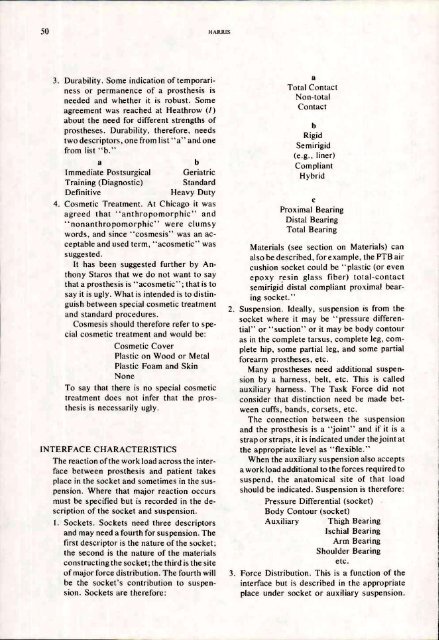Orthotics and Prosthetics
Orthotics and Prosthetics
Orthotics and Prosthetics
Create successful ePaper yourself
Turn your PDF publications into a flip-book with our unique Google optimized e-Paper software.
3. Durability. Some indication of temporariness<br />
or permanence of a prosthesis is<br />
needed <strong>and</strong> whether it is robust. Some<br />
agreement was reached at Heathrow (1)<br />
about the need for different strengths of<br />
prostheses. Durability, therefore, needs<br />
two descriptors, one from list "a" <strong>and</strong> one<br />
from list "b."<br />
a<br />
Immediate Postsurgical<br />
Training (Diagnostic)<br />
Definitive<br />
b<br />
Geriatric<br />
St<strong>and</strong>ard<br />
Heavy Duty<br />
4. Cosmetic Treatment. At Chicago it was<br />
agreed that "anthropomorphic" <strong>and</strong><br />
"nonanthropomorphic" were clumsy<br />
words, <strong>and</strong> since "cosmesis" was an acceptable<br />
<strong>and</strong> used term, "acosmetic" was<br />
suggested.<br />
It has been suggested further by Anthony<br />
Staros that we do not want to say<br />
that a prosthesis is "acosmetic"; that is to<br />
say it is ugly. What is intended is to distinguish<br />
between special cosmetic treatment<br />
<strong>and</strong> st<strong>and</strong>ard procedures.<br />
Cosmesis should therefore refer to special<br />
cosmetic treatment <strong>and</strong> would be:<br />
Cosmetic Cover<br />
Plastic on Wood or Metal<br />
Plastic Foam <strong>and</strong> Skin<br />
None<br />
To say that there is no special cosmetic<br />
treatment does not infer that the prosthesis<br />
is necessarily ugly.<br />
INTERFACE CHARACTERISTICS<br />
The reaction of the work load across the interface<br />
between prosthesis <strong>and</strong> patient takes<br />
place in the socket <strong>and</strong> sometimes in the suspension.<br />
Where that major reaction occurs<br />
must be specified but is recorded in the description<br />
of the socket <strong>and</strong> suspension.<br />
1. Sockets. Sockets need three descriptors<br />
<strong>and</strong> may need a fourth for suspension. The<br />
first descriptor is the nature of the socket;<br />
the second is the nature of the materials<br />
constructing the socket; the third is the site<br />
of major force distribution. The fourth will<br />
be the socket's contribution to suspension.<br />
Sockets are therefore:<br />
a<br />
Total Contact<br />
Non-total<br />
Contact<br />
b<br />
Rigid<br />
Semirigid<br />
(e.g., liner)<br />
Compliant<br />
Hybrid<br />
c<br />
Proximal Bearing<br />
Distal Bearing<br />
Total Bearing<br />
Materials (see section on Materials) can<br />
also be described, for example, the PTB air<br />
cushion socket could be "plastic (or even<br />
epoxy resin glass fiber) total-contact<br />
semirigid distal compliant proximal bearing<br />
socket."<br />
2. Suspension. Ideally, suspension is from the<br />
socket where it may be "pressure differential"<br />
or "suction" or it may be body contour<br />
as in the complete tarsus, complete leg, complete<br />
hip, some partial leg, <strong>and</strong> some partial<br />
forearm prostheses, etc.<br />
Many prostheses need additional suspension<br />
by a harness, belt, etc. This is called<br />
auxiliary harness. The Task Force did not<br />
consider that distinction need be made between<br />
cuffs, b<strong>and</strong>s, corsets, etc.<br />
The connection between the suspension<br />
<strong>and</strong> the prosthesis is a "joint" <strong>and</strong> if it is a<br />
strap or straps, it is indicated under the joint at<br />
the appropriate level as "flexible."<br />
When the auxiliary suspension also accepts<br />
a work load additional to the forces required to<br />
suspend, the anatomical site of that load<br />
should be indicated. Suspension is therefore:<br />
Pressure Differential (socket)<br />
Body Contour (socket)<br />
Auxiliary Thigh Bearing<br />
Ischial Bearing<br />
Arm Bearing<br />
Shoulder Bearing<br />
etc.<br />
3. Force Distribution. This is a function of the<br />
interface but is described in the appropriate<br />
place under socket or auxiliary suspension.
















